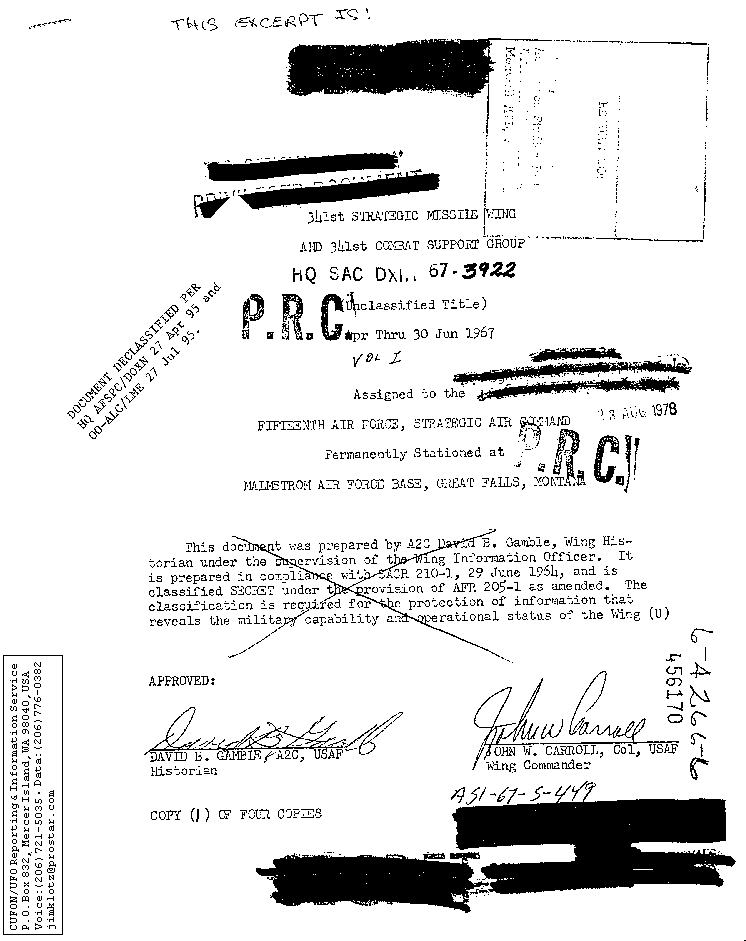
This excerpt is:
SECRET
341st Strategic Missile Wing
& 341st Combat Support Group
HQ SAC DXIH, 67-3922 (Unclassified Title)
apr Thru 30 Jun 1967
vol 1
Assigned to the
Fifteeth Air Force, Strategic Air Command
Permanently Stationed at
Malmstrom Air Force Base, Great Falls, Montana
This document was prepared by A2G David E. Gamble, Wing Historian under the supervision of the Wing Information
Officer. It is prepared in compliance with SACR 210-1, 29 June 1954, and is classified secret under the provision of
AFR 205-1 amended. The classification is required for the protection of information that reveals the military
capability and operational status of the Wing (U).
Approved:
David E. Gamble, A2G, USAF
Historian
John W. Carroll, Col, USAF
Wing Commander
A51-67-5-449
6-4266-6
456170
23 aug 1978
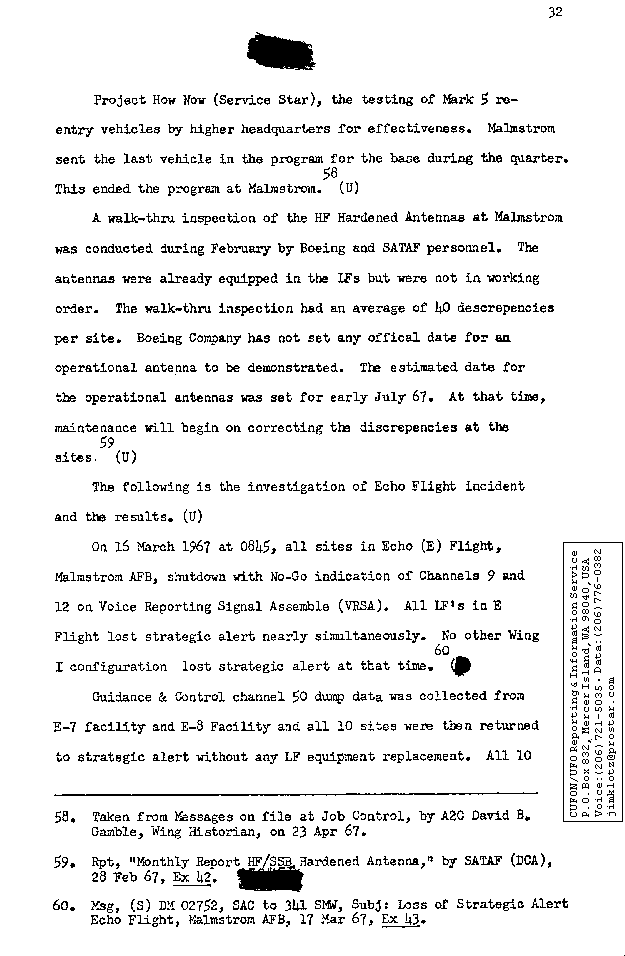
Project How Now (Service Star), the testing of Mark 5 re-entry vehicles by higher headquarters for effectiveness. Malmstrom sent the last vehicle in the program for the base during the quarter. This ended the program at Malmstrom . (U)
A walk-thru inspection of the HF Hardened Antennas at Malmstrom was conducted during February by Boeing and SATAF personnel. The antennas were already equipped in the LFs but there were not in working order. The walk-tru inspection had an average of 40 descrepencies per site. Boeing Company has not set any official date for an operational antenna to be demonstrated. The estimated date for the operational antennas was set for early July 67. At that time, maintenance will begin on correcting the discrepencies at the sites . (U)
The following is the investigation of Echo Flight incident and the results. (U)
On 16 March 1967 at 0845, all sites in Echo (E) Flight, Malmstrom AFB, shutdown with No-Go indication of Channels 9
and 12 on Voice Reporting Signal Assemble (VRSA). All LF's in E Flight lost strategic alert nearly simultaneously. No
other Wing I configuration lost strategic alert at that time .
(S)
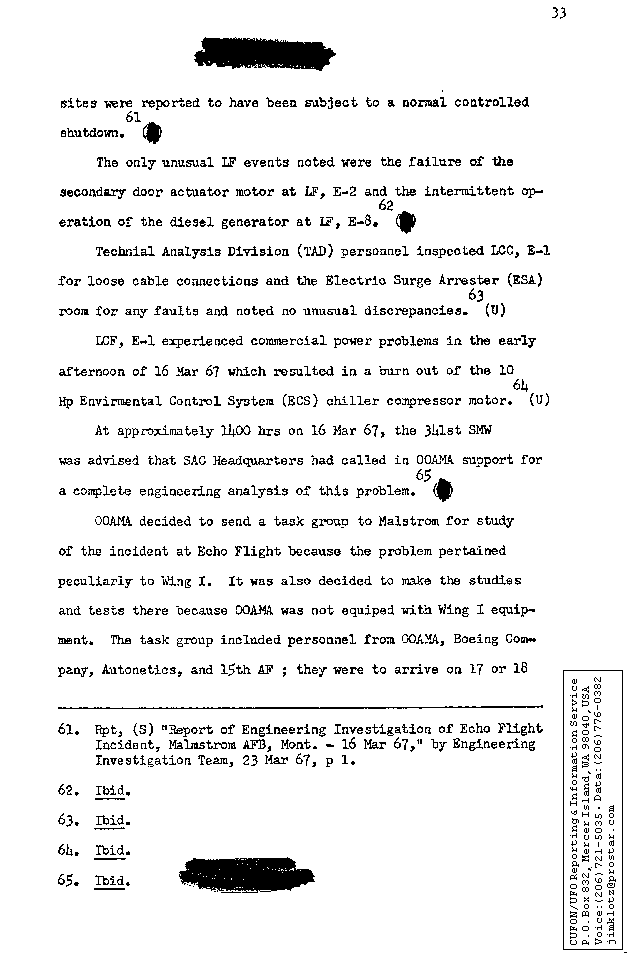
Guidance & Control channel 50 dump data was collected from E-7 facility and E-8 Facility and all 10 sites were
then returned to strategic alert without any LF equipment replacement. All 10 sites were reported to have been subject
to a normal controlled shutdown .
(S)
The only unusual LF events noted were the failure of the secondary door actuator motor at LF, E-2 and the intermittent operation of the diesel generator at LF, E-8 . (S)
Technical Analysis Division (TAD) personnel inspected LCC, E-1 for loose cable connections and the Electric Surge Arrester (ESA) room for any faults and noted no unusual discrepancies . (U)
LCF, E-1 experienced commercial power problems in the early afternoon of 16 Mar 67 which resulted in a burn out of the 10 Hp Envirmental Control System (ECS) chiller compressor motor . (U)
At approximately 1400hrs on 16 Mar 67, the 341st SMW was advised that SAC Headquarters had called in OOAMA
support for a complete engineering analysis of this problem . (S).
OOAMA decided to send a task group to Malmstrom for study of the incident at Echo Flight because the problem
pertained peculiarly to Wing I. It was also decided to make the studies and tests there because OOAMA was not equiped
with Wing I equipment. The task group included personnel from OOAMA, Boeing Company, Autonetics, and 15th
AF ; they were to arrive on 17 or 18 March 67 .
(S)
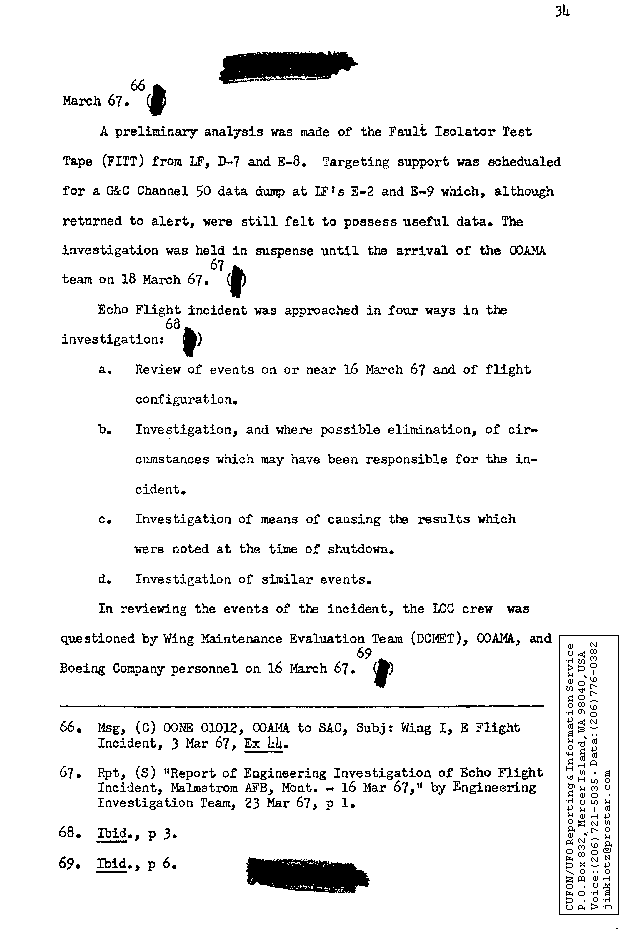
A preliminary analysis was made of the Fault Isolator Test Tape (FITT) from LF, D-7 and E-8. Targeting support was scheduled for a G&C Channel 50 data dump at LF's E-2 and E-9 which, although returned to alert, were still felt to possess useful data. The investigation was held in suspense until the arrival of the OOAMA team on 18 March 67 . (S)
Echo Flight incident was approached in four
ways in the investigation : (S)
- Review of events on or near 16 March 67 and of flight configuration.
- Investigation, and where possible elimination, of circumstances which may have been responsible for the incident.
- Investigation of means of causing the results which were noted at the time of shutdown.
- Investigation of similar events.
In reviewing the events of the incident, the LCC crew was questioned by
Wing Maintenance Evaluation Team (DCMET), OOAMA, and Boeing Company personnel on 16 March 67 .
(S)
In screening the crew it was determined that loss of strategic alert and fault indication occurred in an extremely
short period of time. The exact time estimates could not be obtained but the time interval was estimated to be between
10 and 40 seconds .
(S)
The standby light was not observed to illuminate for any of the ten launching facilities. None of the command and
status line monitor fault lights were illuminated. There was no pattern or sequence noted as to the illumination of
fault and loss of strategic alert. No flickering or ripple was noted on any of the other status displays. The
emergency lights were on (all other lights off) and these lights did not appear to dim . (S)
The initial time of the incident, decided by the crew, could be no more than two or three minutes earlier than the
official log time of 0845 hours (local) . (S)
The crew also stated; the LF, E-8 had a channel 26 which indicated it was operating on diesel at the time of the
fault. The 465L (SAC Communications & Control System) and communications equipment was not processing traffic at
the time of the incident . (S)
Neither of the crew members were using any electrical equipment. Such as electric razor... etc. At the time of fault
the deputy commander was turned away from the console to brief the commander who had just been awakened from sleep.
The commander was the first to see the faults .
(S)
Channel 50 data was extracted from sites E-7 to E-8 immediately after the shutdown of the entire flight. Analysis of this data determined that both sites were shutdown at a result of external influence to the G&C, no No-Go's were detected by the G&C. Although E-8 had indications of a previous Monitor check No-Go it was not the cause of shutdown at this time. This was determined by information contained in sector 54 which said that subsequent to the last No-Go the G&C had completed an iteration routine which is performed approximately 2 hours and 30 minutes into a restart. Had a G&C No-Go caused the shutdown, the Discrete Input "A" (DIA) word would have been placed in this sector . (U)
On Sunday, 19 March 67, a team was dispatched to sites E-2 and E-9 to dump channel 50 data. These two sites were in strategic alert at this time but were selected because they had never experienced a restart since the last time that a maintenance tape had been used. Information from the No-Go sectors of channel 50 indicated that these G&C's had never entered a No-Go loop at any time. This hardens the case against a No-Go causing a shutdown of the flight. If a No-Go had shutdown the flight, it would have been recorded in channel 50 data . (S)
The only non-detectable fault from the G&C section which could have caused a No-Go would have been loss of confirm codes. This type of fault would not have produced a VRSA channel 9 and 12, but only a channel 9. This information eliminated the No-Go theory as the cause of the incident . (U)
As stated earlier, all 10 launch facilities shutdown with a VRSA channel 9 and 12 (G&C No-Go and Logic Coupler
No-Go) recordings. Because of this consistency considerable investigation was expended in the Logic Coupler area. In
the channel 50 analysis it was shown that the guidance section did not experience a No-Go and therefore, it was felt
that the VRSA channel 9 report was not valid. It is possible, however, for the Logic Coupler to generate both of these
No-Go indications . (S) (U)
The logic of the coupler was studied by the investigating team in an effort to identify a method by which both VRSA 9
and 12 could be activated. The opinion of the team was that external generated signals caused the generation of these
two channels and shutdown of the launch facilities. The possibility of this is very remote due to the fact that all 10
couplers would have to fail in the flight within a few seconds of each other.
(S) (U)
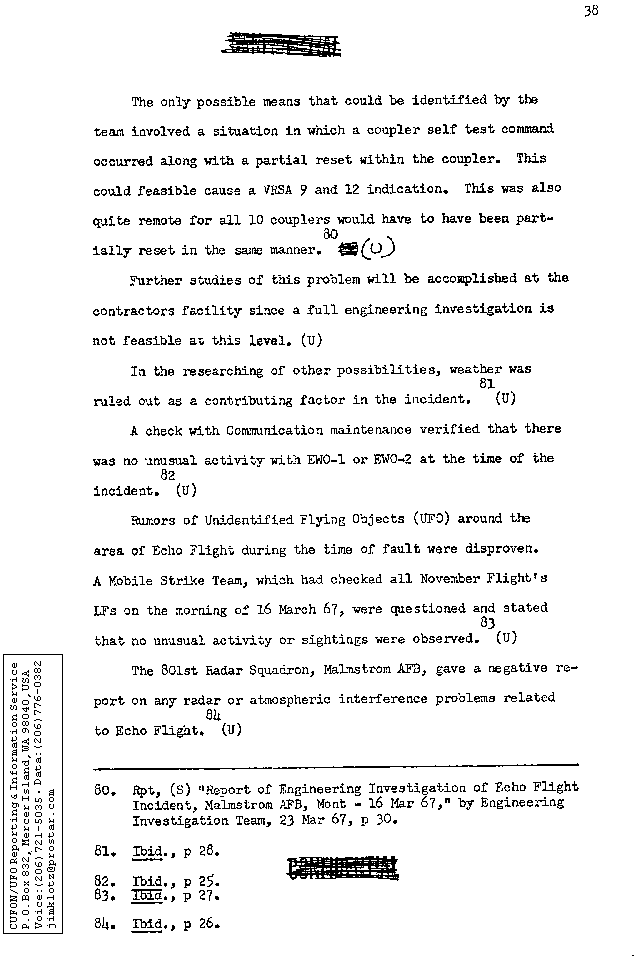
The only possible means that could be identified by the team involved a situation in which a coupler self test
command occurred along with a partial reset within the coupler. This could feasible cause a VRSA 9 and 12 indication.
This was also quite remote for all 10 couplers would have to have been partially reset in the same manner .
(S) (U)
Further studies of this problem will be accomplished at the contractors facility since a full engineering investigation is not feasible at this level. (U)
In the researching of other possibilities, weather was ruled out as a contributing factor in the incident . (U)
A check with Communication maintenance verified that there was no unusual activity with EWO-1 or EWO-2 at the time of the incident . (U)
Rumors of Unidentified Flying Objects (UFO) around the area of Echo Flight during the time of the fault were disproven. A Mobile Strike Team, which had checked all November Flight's LFs on the morning of 16 March 67, were questioned and stated that no unusual activity or sightings were observed . (U)
The 801st Radar Squadron, Malmstrom AFB, gave a negative report on any radar or atmospheric interference problems related to Echo Flight . (U)
Capt. Bradshaw in the command post at the time of Echo Flight incident, verified that there was no activity on the Primary Alerting System (PAS) at Echo Flight . (U)
During the investigation it was discovered that Boeing modification teams were at the sites B-1, K-1 and O-1 on 16 March 67; but this could not have affected anything in the relationship to E Flight because they arrived at the sites after the incident occurred . (U)
As mentioned before, a power problem affected E-1 at 1453 on 16 March 67 according to LCC log. The Brine Chiller (CH-1) shutdown due to power fluctuation. This was not considered unusual for power failures or fluctuations often cause CH shutdowns. Between 1510 and 1600 hours, E-1 experienced another power fluctuation. The capsule crew heard the Motor Generator brushes chatter. At this time the site manager indicated that one phase had low voltage, but LCF power was not appreciably affected since capsule florescent lights were still on. The diesel generator started but could not be put on the line due to broken lead. Commercial power was restored at 1921 hours on 16 March 67 . (U)
In reviewing the maintenance history of the Wing, it was discovered a similar incident occurred at Alpha Flight in
December 1966. On 19 December 66, A Flight had some of it's LFs shutdown (A-6, A-7, and A-10). The similarity between
the two flights was: The same Capsule crew, adverse weather conditions, and commercial power failure after the
facilities shutdown . (S)
Since weather condition and Capsule crew have been eliminated as causes of the incident, investigation of electrical failure was started. (U)
The power outage that affected E-1 at 1453 on 16 March 67, occurred on the 7.2/12.5 kilo volts (KV) tranmission line from the Winifred substation. Fergus Electric Co. (Mr. D. Young, Lewiston) advised Mr. H. Jackson that a transformer shorted one phase of the three south of Winifred . (U)
Sites Echo 1-6 and E-9, E-10, and E-11 are supplied by 7.2 KV line from the Winifred substation. No sites in other flights are supplied power from Winifred. Sites E-7, E-8, D-6, M-2, M-3, and M-8 are supplied power by 7.2 KV lines from the Hilger substation . (U) (See Diagrams)
The source of power comes from the Rainbow generating plant in Great Falls and is fed through the Rainbow switchboard on 100 KV power lines to the Stanford substation. The 100 KV lines continue to Benchland where it feeds two 50 KV lines. One goes to the Glengarry substation at Lewiston and the other to the Harlotow substation. The Glengarry substation feeds the Hilger substation with 50 KV lines and Hilger feeds the Winifred substation with 50 KV lines. The sites are fed by 7.2 KV lines . (U)
A 7.2 KV transformer shorted in the line to site E-3 at 1450, 16 March 67. This transformer is located on a farm two miles south of the Winifred substation. Automatic reclosure switches at Winifred substation opened, and were reclosed manually after transformer replacement later in the day. This caused the Brine Chiller problem at E-1. The transformer was in the West phase. It was not determined which phase this corresponds to at the sites. Sites E-3, E-5, E-6, E-9, and E-10 transferred to Standby Power. Sites E-1 transfered to Direct Current (DC) operation . (U)
On 28 March 67, the 341st SMW in conjunction with the Montana Power Company conducted a switching test on
the 50 KV high voltage line between the Hartowton and Glengarry substations. The test was performed at the request of
OOAMA/OONE as a part of the initial Echo Flight incident investigation performed at Malmstrom. The intent of the test
was to verify correlation, if possible, between high voltage switching and launch facility shutdown or other launch
facility faults .
(S) (U)
After performing the tests, it was decided that commercial power switching operations were not the cause of the E Flight shutdown. This was based on the following reasons. Other flights fed by the Hilger substations were not affected. Similar shutdowns occurred in A Flight LFs which were supplied by power not only from separated substations, but also, from separate feed lines from the generation station. Shutdown in 1965 or 1966 of missiles do not correlate to any power line switching in the Montana Power System . (U)
Since the only common item determined in this investigation was the LCC. The LCC power fault transmitted to the LFs on the hardened cable was considered the only power fault capable of causing the Echo Flight incident . (U)
The investigation teams at Malmstrom, were unable to determine a logical cause for the incident. Further
investigation in the area of shutdown results will be conducted in an effort to determine a possible cause of this
incident. These studies will be conducted at the contractors facility and will be included in the next history . (S)
On 12 January 1967, at 0905 hours, a potential disaster situation occurred while the 341st MIMS Re-entry Vehicle Branch team was being evaluated by the 3901st SMES in performance of a Dash 1 A maintenance on a W-56-Mod 1 warhead . (U)
During the operation a T-290A (instrument to register gaseous air contamination) gave an alarm. The area was immediately evacuated and those present were sent to the Hospital, Decontamination station, for observation of possible contamination . (U)
A Explosive Ordinance Disposal (EOD) team entered the area wearing protective clothing and equiped with a T-290A, plastic bags, and cotton swabs. The warhead was checked with swipe tests for radiation with all results showing negative . (U)
A check was made on the T-290A which gave the alarm and was determined to be faultly. The area was again checked by the team for radiation with no results. The alert was then ended at 1150 hours on 12 January 67 . (U)